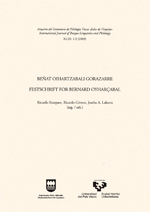Inflexio kanporatze gertakariak euskaraz
##plugins.themes.bootstrap3.article.main##
##plugins.themes.bootstrap3.article.sidebar##
Resumen
This article presents several processes of externalization of inflection of the kind described by Haspelmath (1993) that are found in the diachrony of Basque.
In the first part, we include the main points of the paper "The diachronic externalization of inflection" (Linguistics 31, 1993). In that paper, Haspelmath discusses several instances from various languages in which an inflectional affix which is between a stem and a non-inflectional affix is externalized and ends up outside the non-inflectional affix. Frequently, there are intermediate patterns (hybrid forms) where the inflectional affix occurs twice, both before and after the non-inflectional affix. The mechanism that accounts for such hybrid forms is pleonastic affixation. To explain that mechanism Haspelmath proposes a principle of speaker-conservatism in the diachronic process.
In the second part we focus in the Basque language, and describe some processes whose common trait is the presence of the hybrid forms. Each diachronic process is presented in a table where we include, for each pattern, all the dialect variations used by individual writers of the different literary dialects from the 16th to the 20thcentury. Following the table is a comment on the different dialectal forms found in that table.
The main consequences to be drawn from this analysis are the following: (i) hybrid forms have been considered only as a second hand resource by Basque writers; (ii) diachronically, between the different dialects, and, also inside a given dialect, we do not find any converging trends in the use of hybrid forms. The same thing occurs also in contemporaneous authors of the same dialect. Therefore, the use of hybrid forms seems to be only an individual option.
Cómo citar
##plugins.themes.bootstrap3.article.details##
Esta obra está bajo una licencia Creative Commons Atribución-NoComercial-SinDerivadas 4.0 Internacional.


